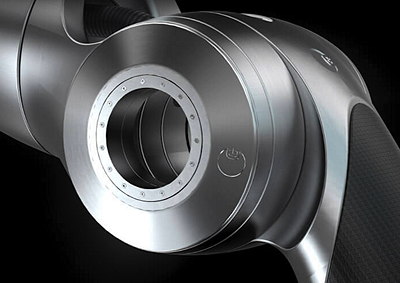According to Genesis, its actuator is three times faster and more powerful than conventional actuators, 100 times more precise, and has a torque-to-inertia ratio 22 times higher than that of a strain-wave actuator. Other remarkable characteristics include the ability to hit a speed of 200 rpm within a quarter of a revolution, and to change direction instantly when required. The technology could also be adapted to produce linear actuators.
The actuator technology made its European debut at the recent Hannover Fair. A team of up to 44 people have been working on the technology in “stealth mode” for the past two-and-a-half years, before revealing the development a few weeks ago. Genesis has spent around $1m applying for eight patents covering the technology, and has already received five “notices of allowance”.
The 269mm-diameter and 16mm-thick ring-shaped actuator on show in Hannover weighs 5.1kg and can deliver a peak torque of 120Nm (54Nm continuous). It has a top speed of 400 rpm (limited by the performance of its bearings), and is claimed to have a repeatability of 0.2 arc-seconds, and a torque-to-inertia ratio of 2.2kNm/kgm2. The actuators can be stacked together to achieve higher ratings, and could be scaled to different sizes. They can be used with existing controllers.
The actuator is the brainchild of Genesis’ founder and chief technology officer, James Klassen. There are three key aspects to the design. The first is an “amplifying” technique that is claimed to almost double the force of the permanent magnets used in the devices. The force is said to be so powerful that it would collapse a conventional motor. So, the second development was to design a rigid structure to withstand these forces. The third discovery was a way to dissipate the high levels of heat that a motor of this power generates.
Because the actuators do not need gears, belts or pulleys, they can stop or change direction extremely quickly – thus improving safely. The mechanical components needed for traditional robotic actuators create backlash, compliance and high inertia – all of which reduce safety, according to Genesis.
At Hannover, Genesis was focusing on potential uses for its technology in robots. The company argues that conventional robotic actuators – which represent about 30% of the total cost of a robot – have several drawbacks. They are relatively slow, which limits their productivity. Their backlash affects precision, while their relatively high inertias hamper rapid safety stops. High back-drive friction, combined with the high inertia, can make gear drives susceptible to damage during impacts – either accidental or intentional.

The LiveDrive actuators could be integrated into robot joints, changing the way that robots are designed and built
The elimination of backlash in the new actuators should avoid jerky movements, and because of their simplicity – there is only one moving part – they are expected to be reliable and easy to manufacture. According to Klassen, they are also “difficult to damage”. The actuators do not contain much copper, thus cutting their costs. Genesis reckons that they could halve the cost of developing a robot.
“Traditional gearbox and drive belt actuators are holding back the entire robotics industry,” Klassen argues. “Existing direct-drive actuators are too heavy to use in robotics,” he adds. “Combined, our three discoveries achieve a level of torque-to-weight that is significantly higher than any other direct-drive motor on the market. We believe this will change the entire industry by allowing the LiveDrive to be used directly in the joints of robots.”
Klassen’s vision for the new technology goes beyond using the actuators in industrial robots. “Imagine a world where rehab involves putting on an exoskeleton and programming it to do your physio exercises, or where healthcare, military and factory workers can have robots assist them with the heavy-lifting required to do their jobs,” he suggests. “Our vision is a world where humans can be assisted – not replaced by – robots, improving overall quality of life. LiveDrive makes this possible, as the technology makes it safe for humans and robots to interact.”
Genesis Robotics’ CEO, Mike Hilton, expects the new actuator technology to disrupt the robotics market. “We worked to address the limitations of traditional robotics to usher a new era, which will improve the lives of workers and revolutionise entire industries,” he says. “Robots today present safety and productivity concerns for both workers and employers. Our actuators enable robots to stop instantly. This, along with the numerous other benefits of LiveDrive, opens up new possibilities for faster, safer, more versatile robots that improve the human experience.”
The new actuators have been designed to be mass-produced at low cost by robots, but Genesis Robotics is not planning to manufacture the devices itself. It might licence the technology for others to manufacture, or sell the business to a suitable buyer. Genesis’ president Michael Gibney is adamant that he will only sell Genesis to a manufacturer that will make the technology available for others to use. “We want to find the right manufacturer,” he says. “Money is not going to buy us.”
Gibney reports that there was “tremendous” interest in the new technology at Hannover. He estimates that it could take about a year before the new technology enters production.

